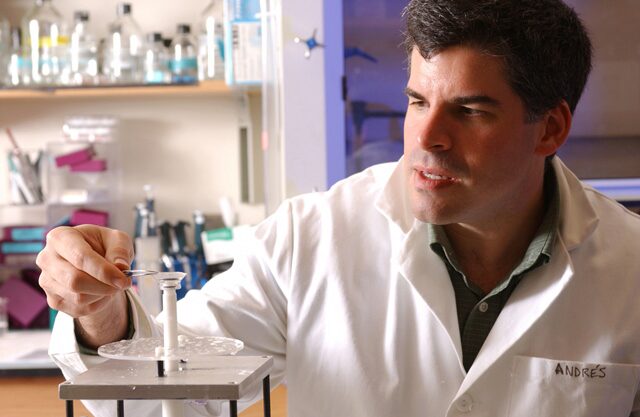Andrés García’s lab in the Parker H. Petit Institute for Bioengineering and Bioscience, which deals with really small-sized stuff, may be onto something really big, and the Juvenile Diabetes Research Foundation (JDRF), who provided the funding for the groundbreaking study, is paying close attention.

Much of the García lab’s research is focused on engineering hydrogels for the delivery of protein and cell therapies. In April, García and a team of researchers in his lab published a research paper with the bulky title, “Microfluidic-Based Generation of Size-Controlled, Biofunctionalized Synthetic Polymer Microgels for Cell Encapsulation,” in the journal Advanced Materials.
“We’ve made a material that is really a hybrid, elements that are pure synthetic chemistry components, and other elements that are biological,” says García, who co-authored the paper with graduate research assistant Deavon Headen from the Wallace H. Coulter Department of Biomedical Engineering, Guillaume Aubry, a postdoctoral fellow in the School of Chemical and Biomolecular Engineering (CHBE), and Hang Lu, CHBE professor and James R. Fair Faculty Fellow.
The paper is getting a lot of attention among researchers, according to García, “and not just people who work in the cell encapsulation area, although some people in this area are very excited about it, and it’s because this strategy shows the potential to have tremendous control in designing the properties of this encapsulation material, and it overcomes a lot of the limitations of the current materials people use. The precise control of this material is what people are excited about.”
In essence, they’ve designed a better way to deliver and protect therapeutic, life-saving cells to people with diabetes.
Every day millions of Americans wake up with the sobering knowledge that they have type 1 diabetes (more than 200,000 of them under age 20), which means that their body’s immune system has mistakenly declared open war on the pancreatic beta cells that make insulin, a hormone that is required in converting food to energy.
Without insulin, glucose builds up to deadly levels in the bloodstream. So, millions of people (mostly people with type 1 diabetes, but some with type 2) give themselves daily insulin injections, or hook themselves up to an insulin pump, in order to stay alive.
There are alternatives – potentially more effective and less grueling treatments – emerging. One of the more exciting, designed to restore natural insulin production, is pancreatic islet transplantation – taking healthy islets (which are actually clusters of about 3,000 cells, including beta cells) from a donor pancreas and transplanting them into diabetes patients.
This replacement therapeutic process has shown terrific promise with some research demonstrating that transplanted islets can function for more than 12 years. But if the body’s immune system detects foreign invaders, it responds aggressively, and may react harshly to these transplanted cells, forcing the need for immune suppression drugs.
Cell encapsulation technologies are being developed to overcome this problem, called graft rejection (and to block the ongoing autoimmune attack of type 1 diabetes) in regenerative medicine. Basically, cells are encapsulated within a membrane that permits two-way diffusion, such as incoming molecules essential for cell metabolism, and outgoing waste products and therapeutic proteins, while the semi-permeability of the membrane keeps the body’s immune system from destroying these benevolent foreign invaders (the encapsulated cells).
“Encapsulated cell therapies are a key research priority for JDRF because they hold broad promise of creating insulin independence for people with type 1 diabetes by physiologically regulating blood sugar levels with replacement cells,” says Albert Hwa, senior program scientist for JDRF. “These therapies could move us beyond the limitations of islet transplantation by utilizing multiple cell sources and avoiding the risks and side effects of strong immune suppression therapies.
“Dr. Garcia’s research improves the way hydrogel microcapsules are made and could be the foundation for next-generation cell replacement therapies. JDRF looks forward to additional testing with these novel capsules.”
For More Information Contact
Jerry Grillo
Communications Officer II
Parker H. Petit Institute
for Bioengineering & Bioscience
